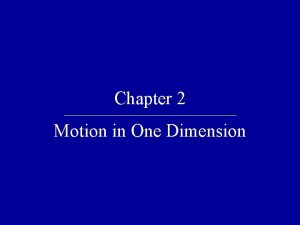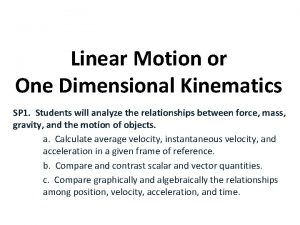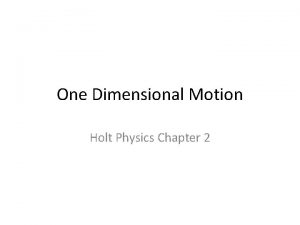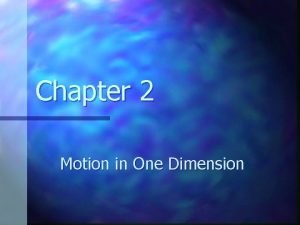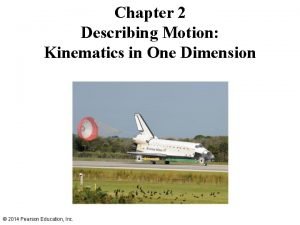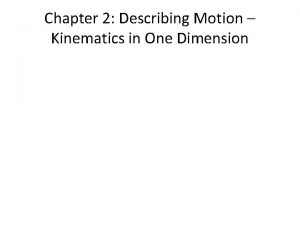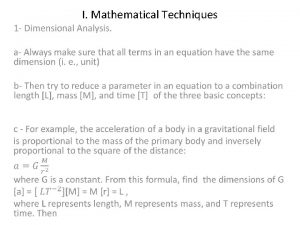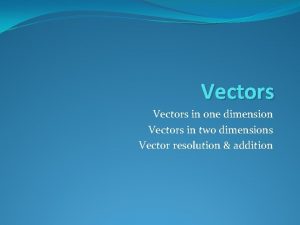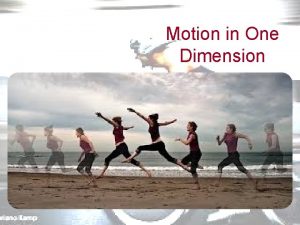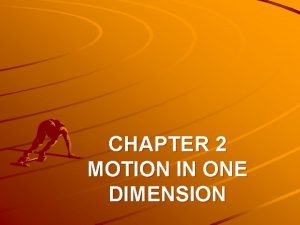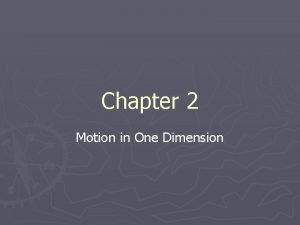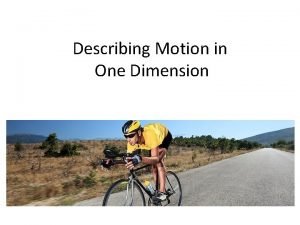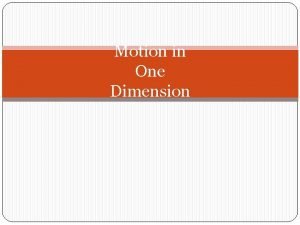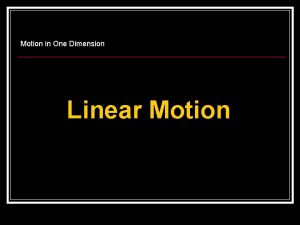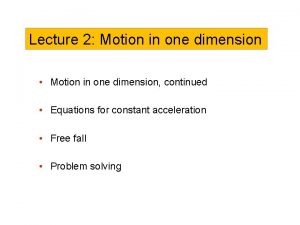Motion in One Dimension Review Return of the













- Slides: 13

Motion in One Dimension Review Return of the revenge. . . And the trouble with Gravity!

Velocity is a vector quantity. Thus, direction is always important and must be indicated. Direction can be indicated by sign (+ versus -) or by specifying a direction, such as East or 75 o.

Acceleration is the rate of change of velocity. It can be a change in speed or direction or both. A = Vf – Vi or ΔV tf – ti Δt

Equations for problems with constant acceleration Vf = Vi + aΔt Δd = ½ (Vf + Vi)Δt (don't use this unless you have no other options, since acceleration is not included) Δd = ViΔt + ½a(Δt)2 Vf 2 = Vi 2 + 2 aΔd

Steps to help solve problems Make a drawing! Decide which direction is positive and which is negative. Reason through the problem before trying to solve it, and write down what you know. Write down the equation (using variables) that you are going to use. Insert numbers into the equation and make sure the units match! Solve the problem mathematically. Check your answer!

Example 1 A speedboat has a constant acceleration of +2. 0 m/s/s. If the initial velocity of the boat is +6. 0 m/s, what is its displacement after 8. 0 seconds? Answer: +110 m

Example 2 A jet is taking off from the deck of an aircraft carrier. Starting from rest, the jet is catapulted with a constant acceleration of +31 m/s/s along a straight line, and reaches a velocity of +62 m/s. Find the displacement of the jet. Answer: +64 m

Example 3 A motorcycle, starting from rest, has an acceleration of +2. 6 m/s/s. After the motorcycle has travelled a distance of 120 m, it slows down with an acceleration of -1. 5 m/s/s until its velocity is +12 m/s. What is the total displacement of the motorcycle? Find the final velocity of the first segment. Then find the displacement of the second segment. Answer: 280 m

Example 4 A stone falls from the top of a large building. After 3. 00 s of free fall, what is the displacement of the stone? Answer: -44. 1 m

Example 5 A football game customarily begins with a coin toss to determine who kicks off. The referee tosses the coin up with an initial speed of 5. 00 m/s. Assuming no air resistance, how high does the coin go above the referee's hand? Answer: 1. 27 m

Example 6 How long is the coin in example 5 in the air? Answer: 1. 02 s

Example 7 A brick falls from a high scaffold. What is its velocity after 4. 0 s? Answer: -39 m/s How far does the brick fall in the first 4. 0 s? Answer: -78 m

Example 8 A tennis ball is thrown straight up with an initial speed of +22. 5 m/s. How long does the ball stay in the air? Answer: 4. 59 s How high does the ball rise? Answer: +25. 9 m
 Motion in one dimension quiz
Motion in one dimension quiz The ticker tape case graph
The ticker tape case graph Vf-vo
Vf-vo A man named bungkas climbed a palm tree
A man named bungkas climbed a palm tree Free fall motion in one dimension
Free fall motion in one dimension Motion in one dimension
Motion in one dimension Describing motion kinematics in one dimension
Describing motion kinematics in one dimension Describing motion kinematics in one dimension
Describing motion kinematics in one dimension Vy=vyo-gt
Vy=vyo-gt Motion in one dimension
Motion in one dimension Forces in one dimension chapter 4
Forces in one dimension chapter 4 Chapter review motion part a vocabulary review answer key
Chapter review motion part a vocabulary review answer key Graphical representation of shm
Graphical representation of shm Vectors in one dimension
Vectors in one dimension
